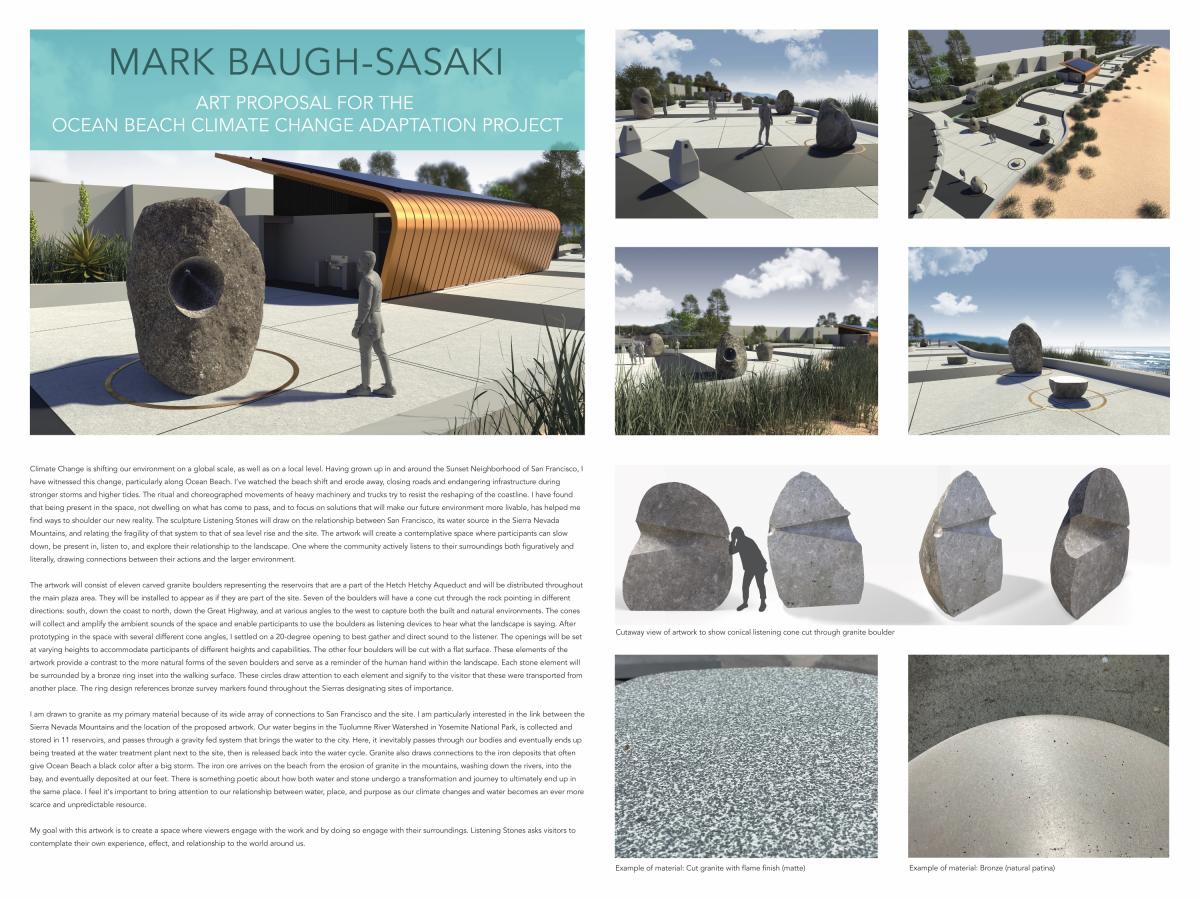 Climate Change is shifting our environment on a global scale, as well as on a local level. Having grown up in and around the Sunset Neighborhood of San Francisco, I have witnessed this change, particularly along Ocean Beach. I’ve watched the beach shift and erode away, closing roads and endangering infrastructure during stronger storms and higher tides. The ritual and choreographed movements of heavy machinery and trucks try to resist the reshaping of the coastline. I have found that being present in the space, not dwelling on what has come to pass, and to focus on solutions that will make our future environment more livable, has helped me find ways to shoulder our new reality. The sculpture Listening Stones will draw on the relationship between San Francisco, its water source in the Sierra Nevada Mountains, and relating the fragility of that system to that of sea level rise and the site. The artwork will create a contemplative space where participants can slow down, be present in, listen to, and explore their relationship to the landscape. One where the community actively listens to their surroundings both figuratively and literally, drawing connections between their actions and the larger environment.
Climate Change is shifting our environment on a global scale, as well as on a local level. Having grown up in and around the Sunset Neighborhood of San Francisco, I have witnessed this change, particularly along Ocean Beach. I’ve watched the beach shift and erode away, closing roads and endangering infrastructure during stronger storms and higher tides. The ritual and choreographed movements of heavy machinery and trucks try to resist the reshaping of the coastline. I have found that being present in the space, not dwelling on what has come to pass, and to focus on solutions that will make our future environment more livable, has helped me find ways to shoulder our new reality. The sculpture Listening Stones will draw on the relationship between San Francisco, its water source in the Sierra Nevada Mountains, and relating the fragility of that system to that of sea level rise and the site. The artwork will create a contemplative space where participants can slow down, be present in, listen to, and explore their relationship to the landscape. One where the community actively listens to their surroundings both figuratively and literally, drawing connections between their actions and the larger environment.
The artwork will consist of eleven carved granite boulders representing the reservoirs that are a part of the Hetch Hetchy Aqueduct and will be distributed throughout the main plaza area. They will be installed to appear as if they are part of the site. Seven of the boulders will have a cone cut through the rock pointing in different directions: south, down the coast to north, down the Great Highway, and at various angles to the west to capture both the built and natural environments. The cones will collect and amplify the ambient sounds of the space and enable participants to use the boulders as listening devices to hear what the landscape is saying. After prototyping in the space with several different cone angles, I settled on a 20-degree opening to best gather and direct sound to the listener. The openings will be set at varying heights to accommodate participants of different heights and capabilities. The other four boulders will be cut with a flat surface. These elements of the artwork provide a contrast to the more natural forms of the seven boulders and serve as a reminder of the human hand within the landscape. Each stone element will be surrounded by a bronze ring inset into the walking surface. These circles draw attention to each element and signify to the visitor that these were transported from another place. The ring design references bronze survey markers found throughout the Sierras designating sites of importance.
I am drawn to granite as my primary material because of its wide array of connections to San Francisco and the site. I am particularly interested in the link between the Sierra Nevada Mountains and the location of the proposed artwork. Our water begins in the Tuolumne River Watershed in Yosemite National Park, is collected and stored in 11 reservoirs, and passes through a gravity fed system that brings the water to the city. Here, it inevitably passes through our bodies and eventually ends up being treated at the water treatment plant next to the site, then is released back into the water cycle. Granite also draws connections to the iron deposits that often give Ocean Beach a black color after a big storm. The iron ore arrives on the beach from the erosion of granite in the mountains, washing down the rivers, into the bay, and eventually deposited at our feet. There is something poetic about how both water and stone undergo a transformation and journey to ultimately end up in the same place. I feel it’s important to bring attention to our relationship between water, place, and purpose as our climate changes and water becomes an ever more scarce and unpredictable resource.
My goal with this artwork is to create a space where viewers engage with the work and by doing so engage with their surroundings. Listening Stones asks visitors to contemplate their own experience, effect, and relationship to the world around us.
View a larger image of the proposal
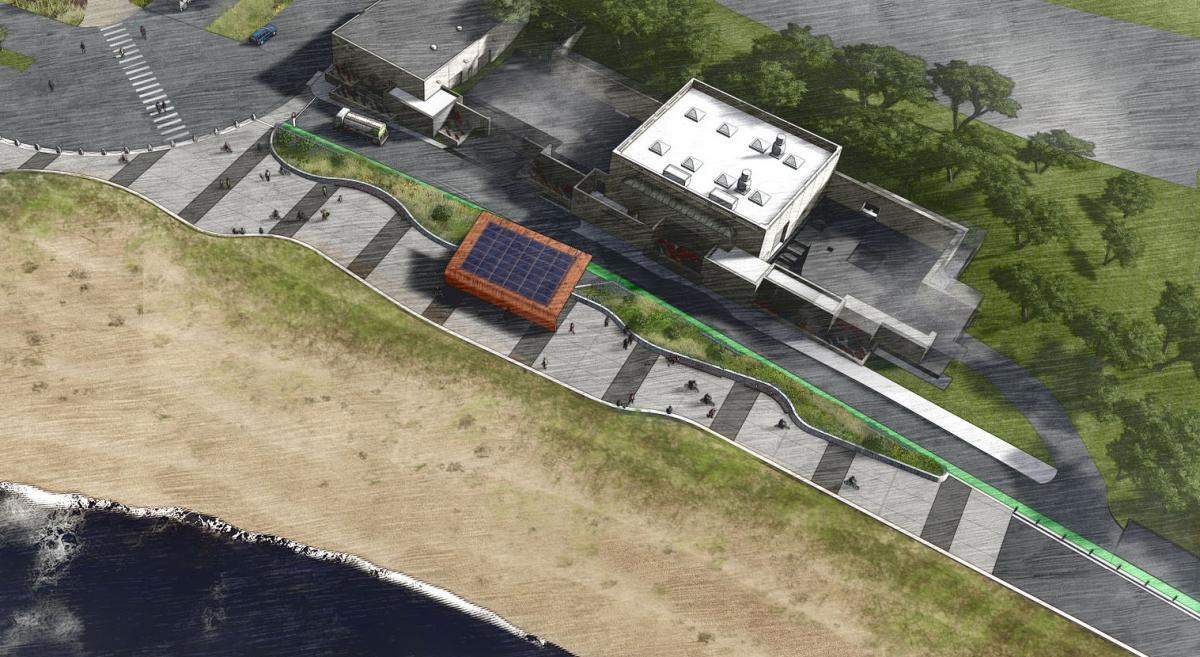 The San Francisco Arts Commission is conducting a review process to choose an artist to create a sculpture or series of sculptures for the new Ocean Beach Climate Change Adaptation Project. The artwork should be inspired by or respond to climate change. With the plaza’s proximity to the beach and ocean, the artwork should be constructed of durable materials and able to withstand harsh weather conditions. Additionally, the work should be an anchor point/ landmark for the new plaza, complement views to and along the ocean and scenic coastal areas, and relate to and be visually compatible with the character of the site and surrounding areas. Three artists were chosen as finalists by a Public Art Review Panel to design site-specific proposals for this artwork opportunity. They are Mark Baugh-Sasaki, Leo Bersamina, and Ana Teresa Fernandez.
The San Francisco Arts Commission is conducting a review process to choose an artist to create a sculpture or series of sculptures for the new Ocean Beach Climate Change Adaptation Project. The artwork should be inspired by or respond to climate change. With the plaza’s proximity to the beach and ocean, the artwork should be constructed of durable materials and able to withstand harsh weather conditions. Additionally, the work should be an anchor point/ landmark for the new plaza, complement views to and along the ocean and scenic coastal areas, and relate to and be visually compatible with the character of the site and surrounding areas. Three artists were chosen as finalists by a Public Art Review Panel to design site-specific proposals for this artwork opportunity. They are Mark Baugh-Sasaki, Leo Bersamina, and Ana Teresa Fernandez.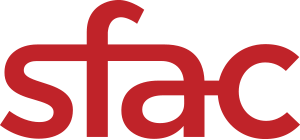
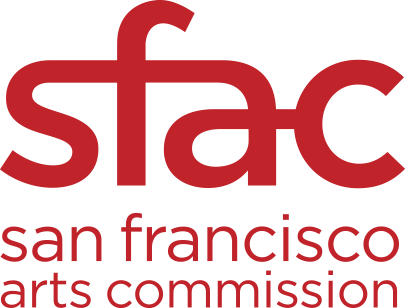

 Climate Change is shifting our environment on a global scale, as well as on a local level. Having grown up in and around the Sunset Neighborhood of San Francisco, I have witnessed this change, particularly along Ocean Beach. I’ve watched the beach shift and erode away, closing roads and endangering infrastructure during stronger storms and higher tides. The ritual and choreographed movements of heavy machinery and trucks try to resist the reshaping of the coastline. I have found that being present in the space, not dwelling on what has come to pass, and to focus on solutions that will make our future environment more livable, has helped me find ways to shoulder our new reality. The sculpture Listening Stones will draw on the relationship between San Francisco, its water source in the Sierra Nevada Mountains, and relating the fragility of that system to that of sea level rise and the site. The artwork will create a contemplative space where participants can slow down, be present in, listen to, and explore their relationship to the landscape. One where the community actively listens to their surroundings both figuratively and literally, drawing connections between their actions and the larger environment.
Climate Change is shifting our environment on a global scale, as well as on a local level. Having grown up in and around the Sunset Neighborhood of San Francisco, I have witnessed this change, particularly along Ocean Beach. I’ve watched the beach shift and erode away, closing roads and endangering infrastructure during stronger storms and higher tides. The ritual and choreographed movements of heavy machinery and trucks try to resist the reshaping of the coastline. I have found that being present in the space, not dwelling on what has come to pass, and to focus on solutions that will make our future environment more livable, has helped me find ways to shoulder our new reality. The sculpture Listening Stones will draw on the relationship between San Francisco, its water source in the Sierra Nevada Mountains, and relating the fragility of that system to that of sea level rise and the site. The artwork will create a contemplative space where participants can slow down, be present in, listen to, and explore their relationship to the landscape. One where the community actively listens to their surroundings both figuratively and literally, drawing connections between their actions and the larger environment.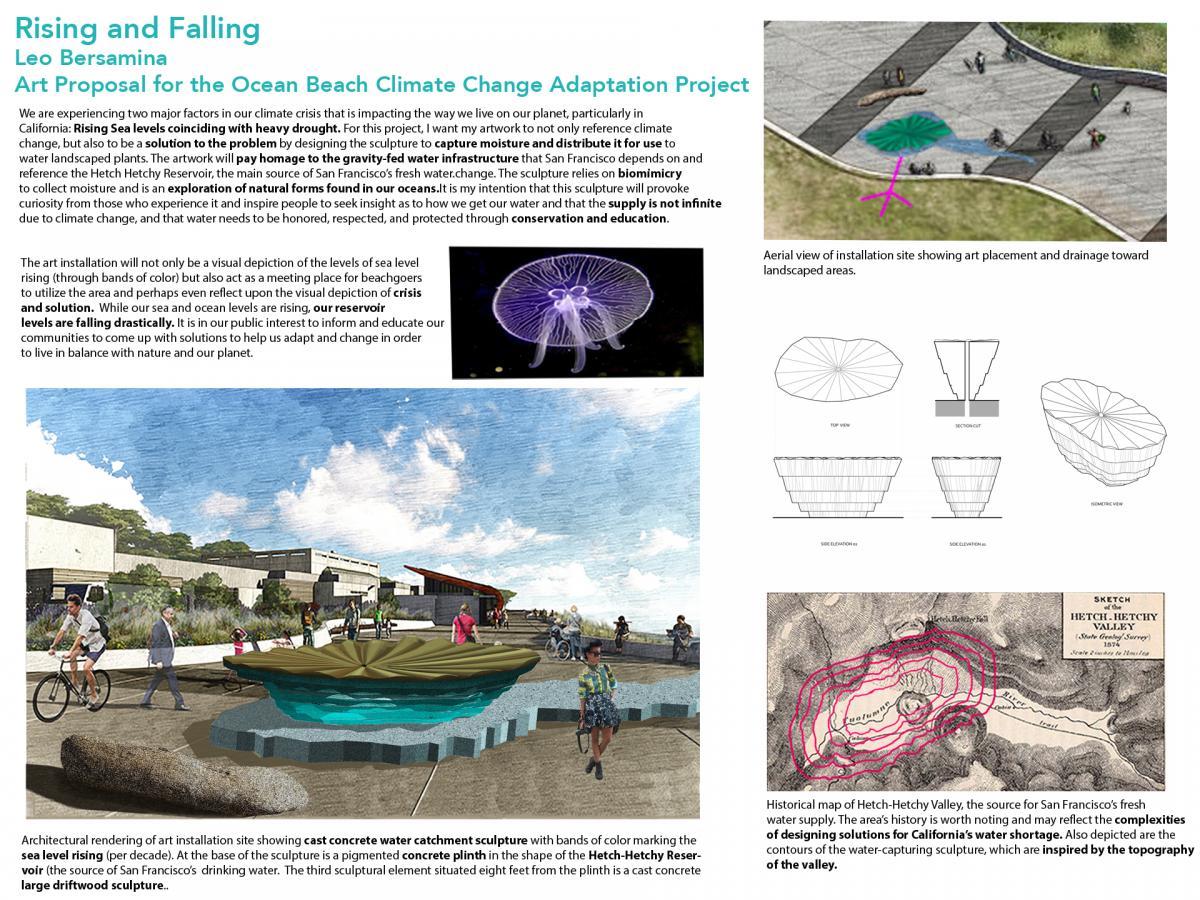 We are experiencing two major factors in our climate crisis that is impacting the way we live on our planet, particularly in California: Rising Sea levels coinciding with heavy drought.
We are experiencing two major factors in our climate crisis that is impacting the way we live on our planet, particularly in California: Rising Sea levels coinciding with heavy drought.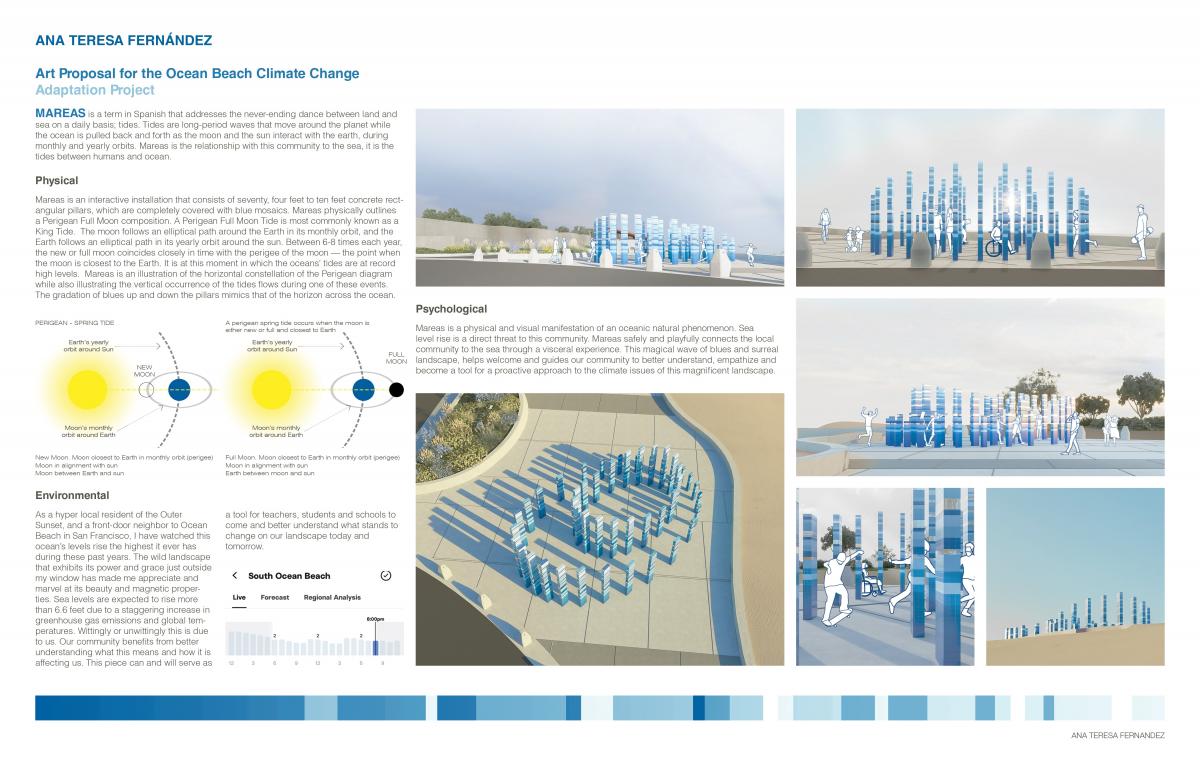 Marea is a term in Spanish that addresses the never-ending dance between land and sea on a daily basis; tides. Tides are long-period waves that move around the planet while the ocean is pulled back and forth as the moon and the sun interact with the earth, during monthly and yearly orbits. Mareas is the relationship with this community to the sea, it is the tides between humans and ocean.
Marea is a term in Spanish that addresses the never-ending dance between land and sea on a daily basis; tides. Tides are long-period waves that move around the planet while the ocean is pulled back and forth as the moon and the sun interact with the earth, during monthly and yearly orbits. Mareas is the relationship with this community to the sea, it is the tides between humans and ocean.
Opportunity For Public Comment
The Final Review Panel will take place remotely on Wednesday, September 28th at 1:00 to 5:00pm and will be open to the public. An agenda for the meeting will be posted 72 hours in advance of the date and can be found on SFAC’s website calendar: https://www.sfartscommission.org/calendar